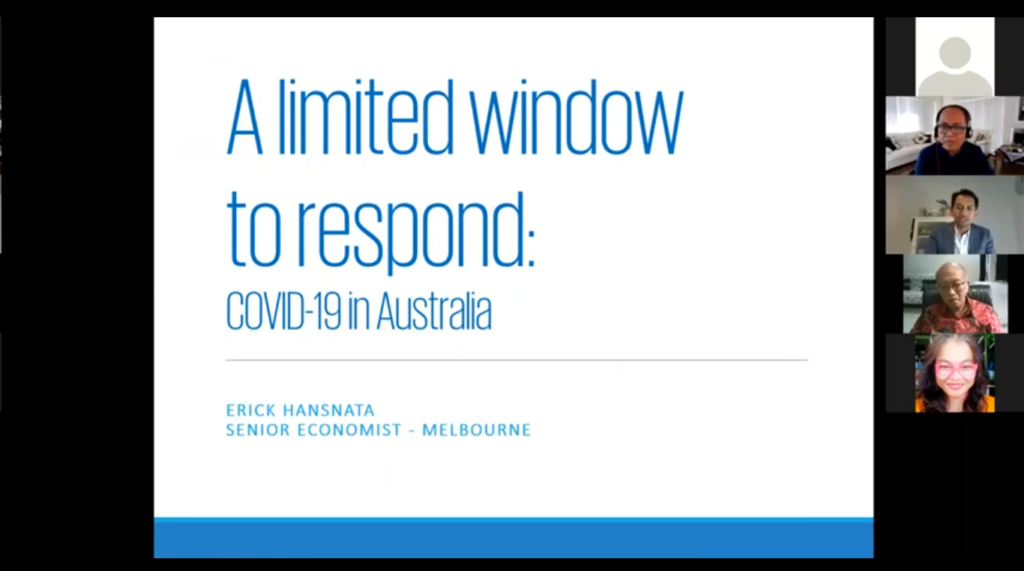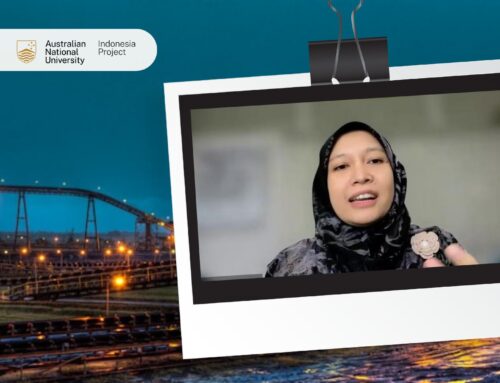The seminar aimed at giving some comparative perspectives on what measures have been introduced in other countries and how they might or might not work in Indonesia. Erick Hansnata from KPMG Australia discussed the relevant measures in Australia; Ari Perdana from the Asian Development Bank talked about President Duterte’s policy in the Philippines, and Puspa Amri from Sonoma State University talked about public health responses from various states and counties in the United States – and the gigantic disaster relief recently rolled out by the US government. Finally, Haryo Aswicahyono from the Centre for Strategic and International Studies provided an update on the situation in Indonesia and explored which lessons from other countries that may fit with Indonesia.
Erick Hansnata is a Senior Economist at KPMG Australia. Ari Perdana is an Evaluation Specialist at the Asian Development Bank. Puspa Amri is Assistant Professor of Economics at Sonoma State University. Haryo Aswicahyono is a Senior Economist at the Centre for Strategic and International Studies.
KEYPOINTS
- Indonesia should learn from other countries on how to scale up public health measures to save people’s lives first and to provide the right mix of economic stimulus.
- Countries around the globe experience the loss of livelihoods through unemployment and failing businesses as a consequence of public health orders taken to delay the spread of COVID-19.
- Stimulus packages are released by each country as social safety nets and as supports for the healthcare systems.
SUMMARY
- As the number of COVID-19 cases soar to nearly one million people worldwide, countries are balancing public health and economic policies/stimuli to save lives, to avoid as much suffering as possible for businesses and individuals, and to reduce long term damages.
- Principal public health measures taken by many countries, including Australia, the Philippines, and the United States, are the implementation of various degrees of social distancing and mobility reduction.
- At least 8 out of 10 people in Australia should practice social distancing compliance to ensure the curve is flattened and to buy time for the healthcare system to prepare for the healthcare turmoil. Australia cancels large events, closes schools, and commands a maximum of 2 people for both indoor and outdoor gatherings when the country hit nearly 2000 confirmed cases. International and domestic travels are banned.
- The Philippines commanded a ‘soft’ lockdown with community quarantine in Luzon Island, where the capital Metro Manila is located.
- The United States has a variation of ‘stay at home’ order with some States mandating and some advising the order.
- Orders by the governments to implement social distancing and mobility reduction is followed by stockpiling of household goods by the public. Over time the stockpiling decreases and citizens gradually comply to the governments’ advise. A higher compliance level to stay at home is currently observed as more and more people recognise the need to flatten the curve.
- Two major economic consequences following the implementation of strict public health measures are (1) a sharp increase in unemployment due to (2) closures of businesses (especially in the tourism, hospitality, transports and the retail sectors).
- These countries released various fiscal stimuli programs as social safety nets for the unemployed workers and as supports for businesses.
- Australia announced a wage subsidy to help employers pay their workers’ income, income support to individuals and households, tax-free cash flow, asset write-off, and backing of business investment. Rental moratorium for businesses and households are also in place.
- The Philippines announced a US$3.9 billions aid and stimulus package with cash transfers included.
- United States announced direct cash transfers, payroll protection/grants loans for small businesses, and direct loans to large companies.
- More public health measures are released as the healthcare system begins to be overwhelmed by the increasing number of cases.
- Australia currently has 60,000 hospital beds and 2,200 ICU beds (in public hospitals) with 47,000 doctors and 160,000 nurses. They have further invested in telehealth and mental health support for potential financial distress. Agreements with private hospitals are also in place in various States.
- The Philippines currently has 101,000 hospital beds. Their broad-reach universal health coverage, Philhealth, has helped people to receive medical care, include expenses of coronavirus patients.
- The United States follows up with mass testing and preparations of ICU beds, ventilators, healthcare workers, alternate care sites, and personal protection equipment (PPE) for health workers.
- Since the start of the outbreak, Indonesia has released three stimulus packages initially focusing on supporting the economy but eventually balancing between saving lives and the economy.
- In February 25, US$724 million stimulus was released to support the tourism, airline, and housing sectors.
- In March 13, US$8 billion stimulus was released to provide tax break for employers, manufacturers and importers.
- In March 31, Rp405.1 trillion stimulus was released to aid the health sector, give social protection, provide credit for SMEs, and recover the economy.
- While fiscal and monetary stimuli are released, Indonesia can and should learn from other countries in keeping up the public health measures. Compliance in physical distancing, with a minimum of 80 per cent compliance will flatten the curve and will buy time for the healthcare system, hence saving more lives. In Indonesia, more drastic measures in public health should be taken immediately, while social assistance is gradually provided.
This post was republished from the ANU Indonesia Project website





